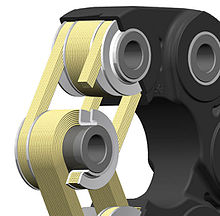Drive joint disc
The flexible drive disc is a flexible coupling that is used to transmit torque . It consists of a composite of wound filaments with elastomer material (rubber) and differs from the hardy disk and from full elastomer couplings .
Layout and function
Articulated drive disks consist of several metal bushings around which wound filaments are wrapped and encased with rubber. The sockets are alternately connected to an input and an output flange by means of a screw connection or socket pins. The torque is transmitted via the inner thread packages, which are loaded in the tensile direction. The filament packages stretch under load, so that flexible drive pulleys behave elastically in all directions. In addition to compensating for axial, radial and angular misalignment, articulated drive disks can therefore also be used to dampen torsional vibrations .
Properties and uses
The forces in operation are transmitted via the combination of internal thread packages and rubber. The permissible tension within the rubber-thread composite is approx. 15 times higher than with pure rubber parts, so that relatively high torques can be transmitted with small dimensions. In the automotive industry in particular, these properties have led to the flexible drive disk being used very often to connect drive shafts (cardan shafts). In this application, the component functions in a similar way to a joint, but in contrast to the universal joint and constant velocity joint, it has a torsional vibration damping effect. Articulated drive disks are insensitive to contamination and shock loads, so that they are also used in general mechanical engineering. Applications outside of harvesting machines or in the drive train of vibrating sieves are often equipped with flexible drive disks. In the case of pump and generator drives, flexible drive disks are used both as a single coupling and in duplicate in the form of double-cardanic systems to compensate for axial, radial and angular misalignments of the individual units. To couple the internal combustion engine and hydraulic pumps, flexible drive disks are often used in a plugged-in design, because the encapsulation of the drive means that screwing is no longer possible after the motor and pump have been brought together.
Executions
Drive joint disks are available in various designs. A basic distinction can be made between flexible drive disks with a preferred direction and flexible drive disks for reversing operation. If the same torques are to be transmitted in forward and reverse operation (reversing operation), thread packages of the same strength are used for both directions of rotation. If there is a preferred direction in the application (e.g. driving forward in an automobile), the thread packages for the preferred direction can be made stronger. Usually, joint drive disks in 4-hole, 6-hole or 8-hole design are used, with the 4-hole variant being able to work at particularly high flexion angles due to its geometric structure. The maximum torque that can be transmitted is limited by the size of the component. If very high torques are to be transmitted, plate ring couplings or plate couplings are used.
Individual evidence
- ↑ Johann Löw, Roland Liessel, SGF Flexible Drive Disks October 11, 2015
